
Lavena Uddin
Lavena is currently finishing her Bachelor of Arts Degree with a Major in Interdisciplinary Studies. Throughout her university journey, she’s studied the many ways in which marginalized groups in different geographical contexts have unequal access to services and opportunities. She’s been recognized on the Dean’s List for her outstanding grades. Outside of school, Lavena enjoys doing research, reading, and writing and hopes to incorporate these skills into her future career opportunities.
Personal Narrative
A vast majority of us here in the global North can access basic services like medical care and participate in educational activities due to the convenience of electricity. This has allowed for safe operations at hospitals, as the World Health Organization (WHO) posits that electricity is essential in powering critical and life saving devices, as well as delivering basic services such as lighting, communications and clean water supply (World Health Organization, 2023), all of which aid in the functioning of essential healthcare services. At the household level, we are not limited to daylight, and can spend our nights studying or conveniently use appliances as needed. It is through this security that we are able to function comfortably, in that our schools, hospitals and businesses run with little to no disruption in terms of energy access. For a portion of the world, this is not the case. In my most recent visit to Bangladesh, I experienced the inconvenience of load shedding, which is the deliberate shut down of electric power to relieve stress on a primary energy source when the demand for electricity becomes greater than what the primary source can supply (Barney & Courtemanche, 2023). This is done to prevent the failure of an entire power grid. On a much larger scale, load shedding can severely affect the medical sector, intensifying the situation for both patients and healthcare providers due to delays in providing service, running tests, and the inability to operate computers and other necessary devices.
I stayed in a fairly urban area, yet issues remained regarding energy accessibility. For the rural poor, these issues are exacerbated, as many rely on traditional sources of fuel such as trees and crop residues, which provide about 68% of their total energy needs (Sarkar & Islam, 1998). Furthermore, the use of biomass and coal, for cooking and heating, can be detrimental to health. Risk factors include indoor air pollution, which is one of the driving causes of pneumonia among children (Mondal & Paul, 2020). Biomass fuels can consist of woods, straw/shrubs/grass, agricultural crops, and animal dung, all of which lie at the lower end of the energy ladder in terms of combustion efficiency and cleanliness (Mondal & Paul, 2020). Moreover, the daily combustion of biomass materials and exposure to air pollution goes beyond what is the standard limit recommended by the WHO (Mondal & Paul, 2020), highlighting the disparity in living standards between industrialized and developing countries. I felt the difference in air quality within a few days of living there and had developed a severe cough and breathing issues because of the pollution.
Fossil-fuel reliance further aggravates the climate crisis, which has influenced many countries to adopt newer and cleaner energy systems, thus phasing out the old fossil-fuel system. However, many people remain disproportionately energy poor and face further implications in terms of health as they cannot access clean energy. With anthropogenic climate change accelerating the occurrence floods and cyclones, as well as contributing to sea-level rise and droughts, an additional 132 million people will be pushed into poverty by 2030, with 216 million being forced to internally migrate within Bangladesh by 2050 (Kundo et al., 2023). Preventative measures can include the integration of renewable energy sources, as it can reduce and ultimately eliminate greenhouse gas emissions related to fossil-fuel combustion, thus playing a key role in mitigating climate change (Dincer & Acar, 2015). In Bangladesh, the use of solar energy or micro-grids can prove to be effective in remote areas that often lack access to the main electric grid. It would also be the most cost-effective option compared to their current use of fossil-fuel thermal power plants, which drains much of the country’s foreign currency reserves while compromising its energy security (“Solar Most Viable Power Source in Bangladesh,” 2023).
By ignoring the energy problem, we risk forcing those in poverty to continue to lack adequate access to utilities that could aid in social progress. Women are particularly affected, in that they are domesticated to household work such as collecting firewood for cooking and heating, handwashing laundry and other duties that have long been replaced by energy-driven technologies in the West. For rural women that face gendered impact of a lack of modern energy access, improving their access can facilitate change for their situation, such that they are able to engage in other pursuits such as education or generating income with their freed-up time (Moniruzzaman & Day, 2020). Many women in the urban areas of Bangladesh, where energy is more accessible, can achieve greater feats outside of the household, sometimes even generating more income than their husbands. This difference is notable in my own family, where my mom’s generation didn’t get access to electricity until later in life, which perhaps inhibited her full potential in terms of educational attainment and job prospects, whereas her youngest sister completed her education and went on to get a high-income job that has allowed her to move to a gated area and enroll her children in private schools. I believe that improved living conditions like lighting and gas stoves, transportation and access to technology and communications has allowed for that to materialize, as she likely would’ve been restricted to household duties like my mom otherwise. Increased access to energy has the potential to advance societies and its citizens, as seen with developed nations, and can allow traditional societies to adopt much of the technologies and qualities that are present here in the global North.
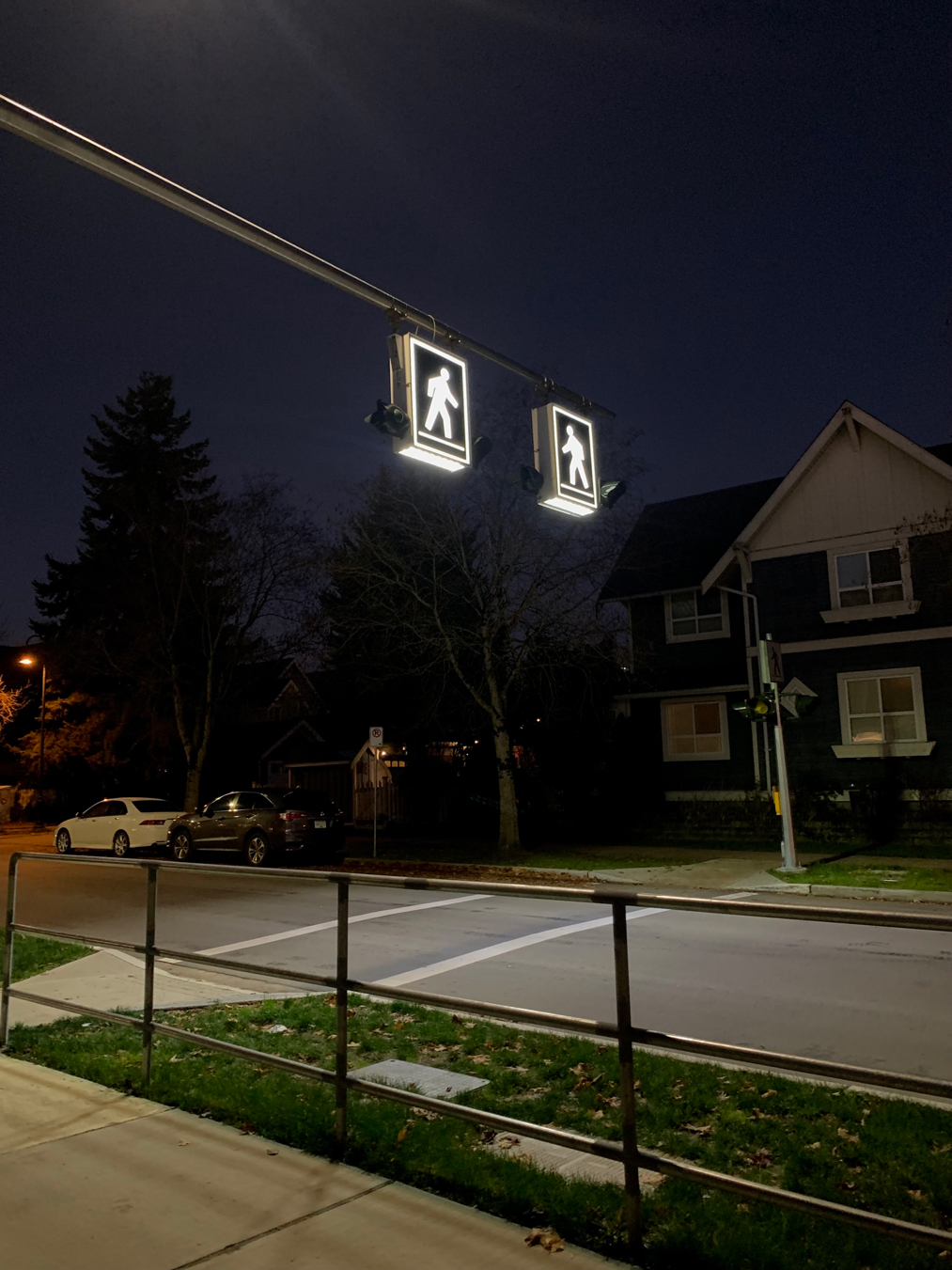
The pedestrian crosswalk in my Queensborough neighbourhood, New Westminster. Despite living in a fairly secluded area, I’ve never really feared walking home alone at night and that has a lot to do with the streets always being illuminated. In Bangladesh, many rural areas or neighbourhoods away from the bustling town were often dark, making it unsafe and scary to be out at night, especially for women.
Introduction
One of the most defining features of a developed nation is its access to reliable and clean energy. Clean energy pertains to energy that is derived from natural sources or processes that are constantly replenished (Shinn, 2022), such as solar, wind and hydropower. This accessibility has allowed for the rapid progression of industrialized nations in achieving longer life expectancies, low rates of child mortality, higher levels of educational attainment and overall better quality of life. This can be attributed to improved hospitals, that utilize electricity for life-saving intervention and in health care services. The World Health Organization (2023) furthers that, “reliable power is…crucial for the medical equipment necessary to safely manage childbirth or to ensure immunization,” which can contribute to longer life expectancies and improved maternal health. Moreover, citizens of developed societies enjoy easy access to clean water, adequate housing, dietary calories, and electrical appliances, (Mazur, 2011), all of which support healthier and fulfilling lifestyles. This has been achieved through “the replacement of traditional fuels, such as woods and candles, and animal power by steam power, and then by electricity and gas, [which has] reduced the risk of fires, made the air in homes cleaner and warmer in winter, and reduced the risk of health hazards associated with animal waste” (Markandya & Wilkinson, 2007). This is contrary to the energy and economic development seen in many countries of the global South including Bangladesh, which are often still decades behind in terms of energy access, resulting in the slow development of various societal aspects like health, education, and child mortality rates.
An evaluation of Bangladesh reveals that power cuts continue to occur frequently despite improved electricity access. Freelance graphic designer, Julfiqar Ali told Al Jazeera that, “Overall, we are getting at most eight to nine hours of electricity a day” (Mahmud, 2023). While temporary power outages are inconvenient at most here in the West, long-term or frequent outages would interfere with much of people’s daily affairs, setting most of us back and disrupting various sectors. However, this is the norm in Bangladesh, as Ali reveals that he has missed deadlines for many of his projects because of the unstable electricity (Mahmud, 2023). Power cuts further interrupt both hospitals and educational institutions, prolonging lab tests and diagnosis and disrupting educational activities (Tajmim & Islam, 2023).
Currently, approximately 10% of the global population do not have access to electricity, with energy poverty in Bangladesh being experienced at a higher rate than income poverty (Sen et al., 2023). It is imperative that we establish modern energy infrastructures and services for the income poor in order to achieve the United Nations’ Sustainable Development Goal 7 (SDG7) of ensuring access to clean and affordable energy for all by 2030 (United Nations). Everyone should have affordable access to clean energy because energy security enhances personal development and boosts economic productivity, thereby improving the conditions of the poor and allowing communities to thrive.
History
Historically, Bangladesh has struggled to generate adequate electricity since its independence from Pakistan, with only 3% of the population having access to electricity in 1971 (Islam & Khan, 2017), but rising to 85% in 2020 (IEA). The Bangladesh Power Development Board (BPDB) was created in 1972 and supplied electricity to urban centres and their peripheries only, due to its limited generation (Debnath & Mourshed, 2022). Rural electrification was pushed aside until 1977, when the Rural Electrification Board (REB) was established, after which energy-sector policy development remained stagnant for almost 25 years (Debnath & Mourshed, 2022). This can explain the country’s slow energy development for rural areas, compared to other rising nations, such as China. China’s rural energy development was first listed in 1982 at the Nation Sixth Five-year Plan during the Fifth National People’s Congress, in which the major measures proposed to counter rural energy problems included, disseminating firewood-saving stoves and household bio-digesters, planting firewood forests and exploiting small hydropower (Keyun et al., 1996). Through these measures, China was able to increase the availability of firewood in rural areas, while the extension of firewood-saving stoves allowed them to alleviate the problem of energy shortage and triggered off the further development of rural energy systems (Keyun et al., 1996). Grid corporations in China have also invested about 300 billion yuan to transform and strengthen rural power grids, which achieved 100 percent electric coverage for all rural villages (Zhou, 2009). Bangladesh has a lot to learn here, in that urban areas were prioritized for energy supply, leaving rural areas especially vulnerable to power cuts due to insufficient investments in power generation (World Bank Group, 2021).
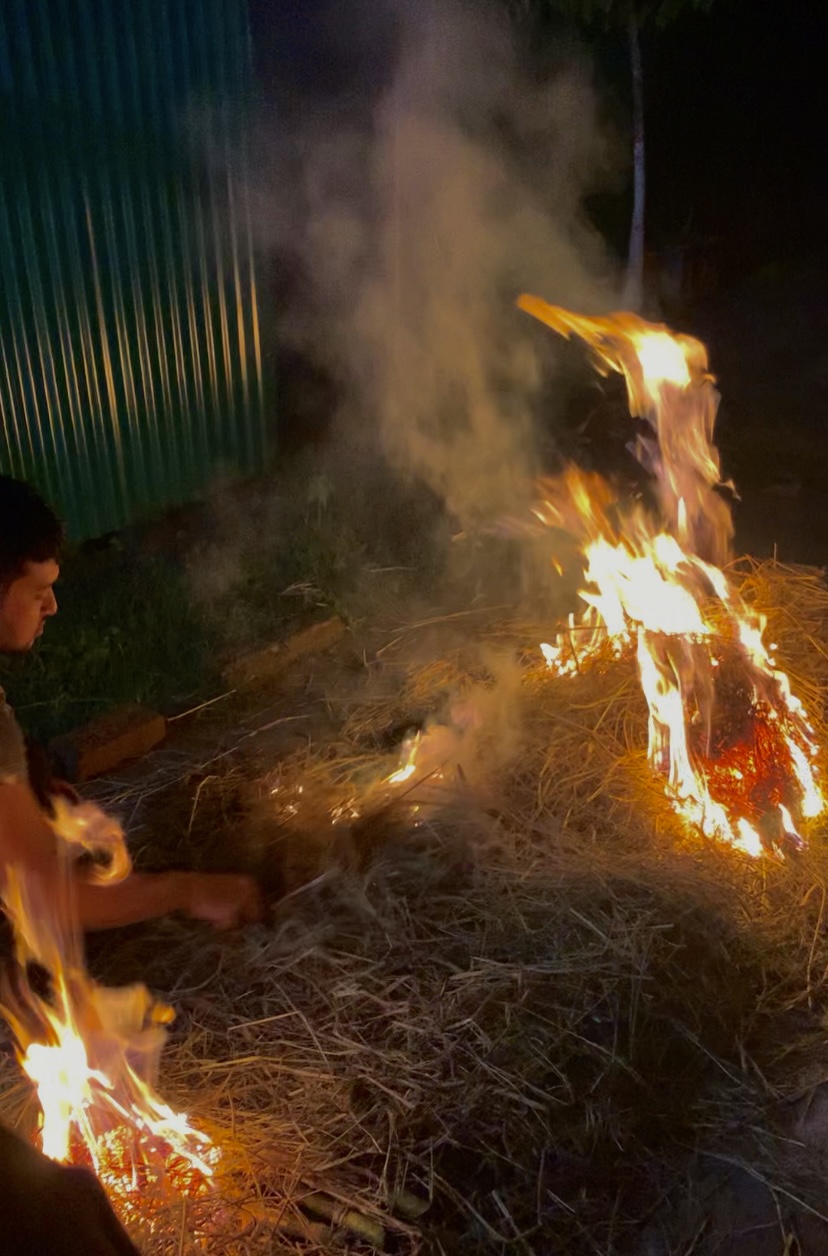
“Baking it in the hay gives it a special kind of taste!” – A neighbour enjoys making a Bangladeshi delicacy using hay and fire despite owning a stove. This shows that some people still enjoy traditional methods of cooking, due to comfort or a food-taste preference.
Methodology
I will analyze three dimensions related to energy inaccessibility and its related effects which will include energy poverty, environmental impact, and health effects. By evaluating these concepts, I hope to cultivate a better understanding of why energy accessibility is important in fostering both personal enhancement and improved societal conditions, while examining potential solutions to combat the effects of energy inaccessibility.
Energy Poverty
Energy poverty is defined by a household’s inability to pay for essential energy services such as heating, lighting, and other required energy services due to their low family income (Hosan et al., 2023). This issue remains more severe in Bangladesh in comparison to other emerging countries despite the energy sector being heavily subsidized (Prizzon, 2020). In 2016, 41% of the total population in Bangladesh lacked access to clean cooking facilities, while about 18% of the total rural population lacked access to electricity in 2019 (Hosan et al., 2023), highlighting a need for governmental policies and services that emphasize energy transition models in a period of de-transition from traditional fossil fuels. Currently, the government of Bangladesh provides oil at a subsidised price to the privately-owned oil-fired Quick Rental (QR) power producers to protect them from price volatility in the oil market (Amin et al., 2022), which although might enhance energy security, does little to reform existing energy policies to achieve sustainable development.
While 88% of the population have electricity access, 79% of those connected to the grid suffer load-shedding and 60% suffer low-voltage supply (Sarker et al., 2020). Load shedding is problematic in the sense that it disables people from accessing necessary services for few hours at a time, which can disadvantage them further. In an interview with a Bangladeshi immigrant, Saifur Rahman, he reveals that, “rich folk…are using IPS (Instant Power Supply), [where] they store the electricity in a battery and then… use it when there is no power. Because in Bangladesh, [the climate is hot] …they need the IPS to use for the fan and led light [as] candles and kerosene lamps accelerate the heat during summer.” This shows a clear distinction between the income poor and the rich, in that the rich can buy a backup power supply for continued energy use during power outages, with load shedding being nothing but a minor inconvenience. A 1000-watt IPS would cost at least 10,000 takas, excluding the battery cost (IPS Price in Bangladesh 2023, n.d.), which is roughly $124.30 CAD.
A high-density population such as Bangladesh could benefit from an increase in their use of energy, as it would spur their economy if their population were able to invest in other services and institutions such as school and healthcare. Energy poverty significantly impacts social well-being as energy-poor households have higher rates of school dropouts and have lower employment opportunities than households that have not experienced such poverty (Hosan et al., 2023). According to the World Bank’s 2019 Tracking SDG7 Report, Bangladesh is among the top twenty “Access Deficit Countries” (Ichord, 2020), which can contribute to its low levels of educational attainment and employment rates. In a personal interview with Dr. Heather Chappells, who completed a PhD on sustainable energy and has worked as a researcher in the UK, she posits that, “A lack of reliable access can seriously undermine social progress, sustainability, and security in many ways. Lack of lighting at home can hinder the ability to study; accessing alternative fuels can be inconvenient and put women and girls at risk; unreliable transportation or internet options restrict opportunities for work or social networking. All of these factors, and many more, can limit people’s ability to participate in processes of social and economic transformation.” Furthermore, the need for electrification has increased in recent emergency of COVID-19, to run the medical equipment and provide sterilized clinics for women to give birth safely (Asghar et., 2022). However, the expansion of economic activities and public spheres are interrupted due to underdeveloped electricity infrastructure and poor management system (Hossain & Hasan, 2018).
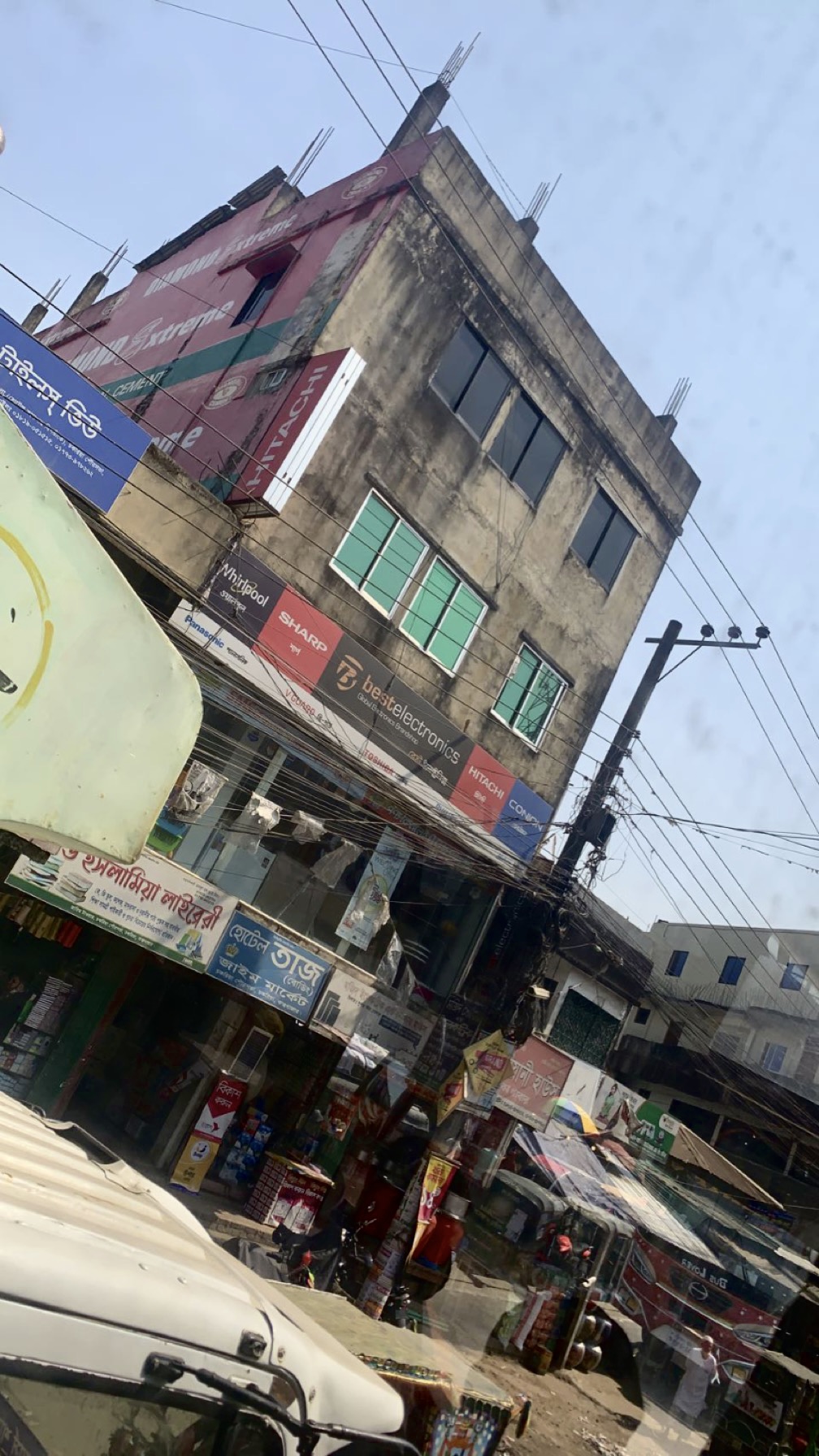
Transmission lines in front of an electronics shop in a small town near Chittagong, Bangladesh. This area was quite dense and underdeveloped, which is ironic with “best electronics” advertised in the middle, considering that frequent power cuts and affordability remains an issue in the area, like many rural parts of Bangladesh.
Environmental Impact
Despite energy access improving, Bangladesh still faces inconsistency in energy access and a lack of clean energy overall, which only furthers its already climate-vulnerable state. Rahman claims that “Bangladesh [has] high pollution from different things – plastic pollution, industrial pollutions… like the garment industry polluting the rivers with chemicals and [the] burning [of] fossil-fuels,” which sheds light onto the unsustainable dependency of traditional fuels and practices that further environmental degradation. This can be illustrated through the use of biomass fuels in rural areas, which often use firewood, resulting in deforestation and land degradation. The emission of greenhouse gases over the energy supply-chain, as well as the local effects of indoor air pollution from solid fuels used for cooking, contribute to growing climate impacts (Uddin & Taplin, 2015). This necessitates the adoption of renewable sources of energy, in order to negate environmental damage while also providing long-term energy access. Among the different renewable energy sources, solar energy is the most viable option for power generation due to its inexhaustible nature (Sarker, et al., 2020). In doing so, a transition towards sustainable energy development and access to modern technologies can occur. Chappells offers that, “solar energy is considered one of the more economically viable renewable options for [Bangladesh] and would be beneficial from both an environmental perspective and for achieving energy security and autonomy,” which presents an opportunity for future developments that, while might still run on current fuel power plants, can make a slow transition towards a system that is much more renewable.
Health Effects and Gendered Impact
The context of Bangladesh infers that evolutionary change needs to occur, as much of the population is not aware of the effects that unclean energy use has on their health. An in-depth interview conducted by (Moniruzzaman & Day, 2020), in the rural village of Shahbazpur in Bangladesh, found that a majority of men were reluctant to believe that traditional fuels caused health problems. One male respondent stated that, “smoke is not a problem. If you cook, it will be produced, very natural” (Moniruzzaman & Day, 2020), suggesting that energy poor individuals often accept and do not see the implications of traditional fuels, whether it is to save money or because their ancestors had been using it for a long time with seemingly “no effects.” The use of biomass in cooking generates toxic chemical gasses such as hydrocarbons, carbon monoxide and oxygenated organics that cause indoor pollution, which contribute to various diseases including pneumonia, tuberculosis, cancers, and cardiovascular diseases (Asghar et al., 2022). This contributes to the high infant mortality rate, with African and South Asian countries facing a higher death rate due to a lack of access to electricity (Asghar et al., 2022). People are further restricted by the lack of services and information available to them, as one female respondent claims that, “nobody consults or advises us about those issues” (Moniruzzaman & Day, 2020), referring to their lack of access to information regarding fuel and appliance options and its costs. This demands an increase of able state actors like government officials or representatives of energy companies, to discuss energy concerns with rural citizens, while offering information that can aid households in making informed decisions about their energy use. This can also allow the women’s concerns to be validated by an expert, as they are often subject to gaslighting and sometimes even abuse, in relation to energy concerns. In line with energy transition efforts, “a multi-level transition perspective would predict that change might be initiated by niche developments in solar energy that could, given the right political conditions in the wider energy landscape, break through to destabilize a current regime that is built around a now outdated fossil fuel economy” (Chappells). Introducing newer models of energy systems and practices where needed can promote steady change that can drastically improve the health of rural citizens, thereby reducing related healthcare costs later in life.
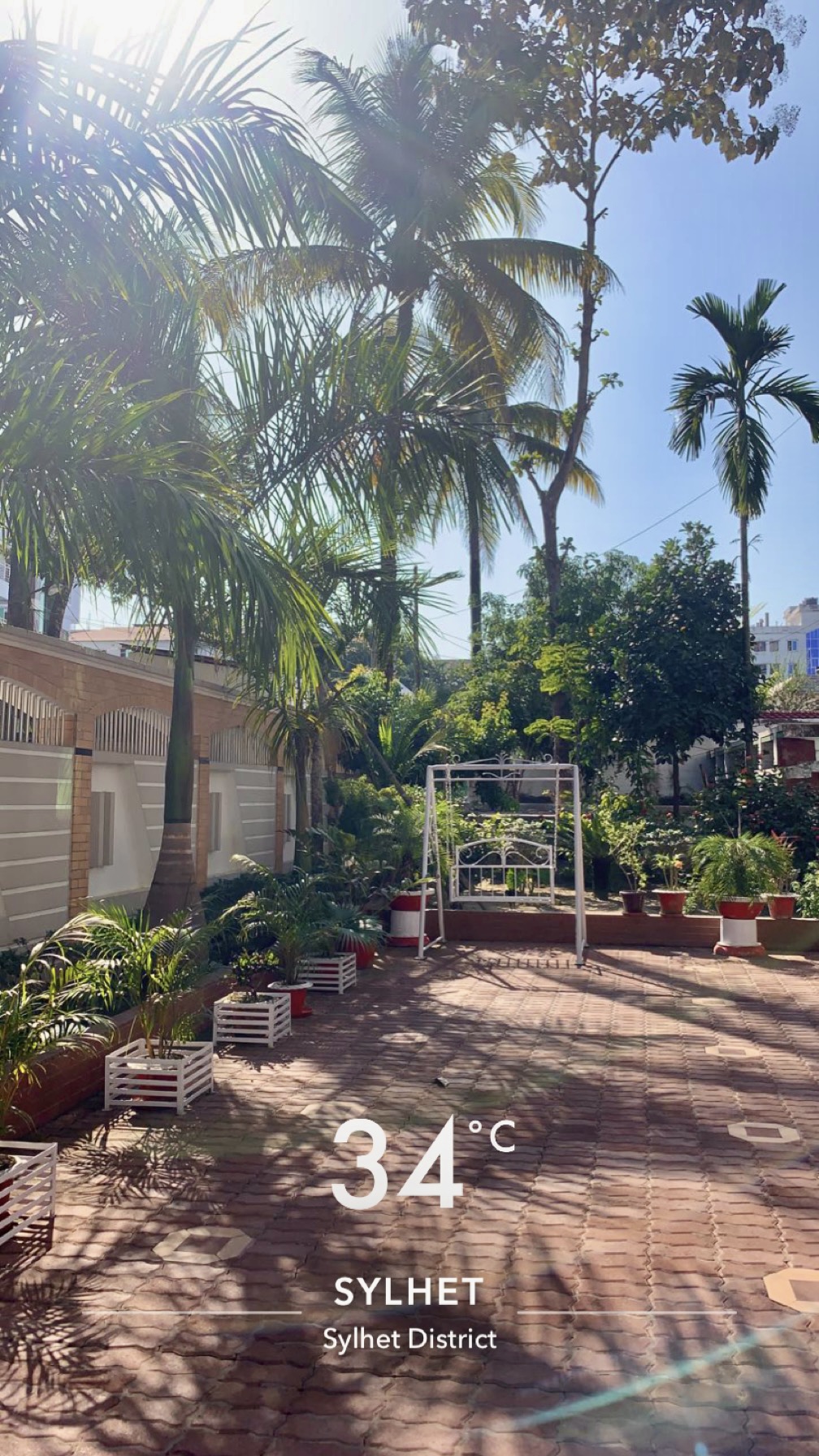
A picture I took in the beginning of March 2022 on Snapchat, to showcase how hot it’d been getting in Bangladesh to my friends and family back home in Vancouver, whom were still experiencing cold, winter-like conditions. Air-conditioning was not common at all in Bangladesh, both in public places and in homes, making it extremely difficult to cool off. With temperatures rising even further in the summer, the use of kerosene lamps and firewood would be especially difficult for rural areas with no electricity or during load shedding.
Solutions
Completely eradicating energy poverty can often seem like an unfeasible goal, but improving access through direct government intervention can help to mitigate its effects. Energy subsidies are an example of deliberate policy action by government, that lowers the cost of producing energy, increases the revenues of energy producers and can lower the price paid by energy consumers for energy (Hosan et al., 2023). This is done through direct budget transfers from the government of Bangladesh to the Bangladesh Power Development Board (BPDB) and Bangladesh Petroleum Corporation (BPC), the two public entities responsible for supplying electricity, natural gas, and oil to the entire country (Hosan et al., 2023). In doing so, households struggling to meet their energy demands can practice safe measures rather than relying on harmful fuels, as well as being able to participate in school, work, or household activities without disruption. For instance, agriculture makes up a significant portion of the labour sector in Bangladesh, with half of the population depending on agriculture for their livelihood (Miskat et al., 2023). As a result, approximately 1.28 million diesel pumps are in operation across the country, and the government must import 1.06 million tons of diesel, spending USD 280 million in annual subsidies to make irrigation more affordable (Miskat et al., 2023). It is important to remember that energy pricing, household income, access to energy appliances and the specific needs of a household are fundamental attributes that determine energy poverty, and energy subsidies play an important role in mediating the effects of energy poverty (Hosan et al., 2023), thus improving social well-being. The share of total subsidies received by households in the electricity sector was raised to 55% in 2016, where it was 21% in 2005 (Hosan et al., 2023), which can reflect its increasing demand over the years. One program developed by the National Team for the Acceleration of Poverty Reduction (Tim Nasional Percepatan Penangulangan Kemiskinan/TNP2K) in Indonesia, in which they provide electricity under a cheap and power-saving program, allowing selected poor households to have grid installation connections for free (Sambodo & Novandra, 2019), can also serve as a model for Bangladesh to follow and implement in its own context. This can serve as a kind of welfare program, allowing the energy poor to have basic access that can later improve their living conditions, having been able to save money from high energy costs.
In line with the SDG7, it is important to evaluate Bangladesh’s current energy sources, in order to implement cleaner, renewable energy systems. In the context of Bangladesh, solar energy appears to have the greatest potential according to various researchers. Firstly, the electricity generation from solar energy increases more than 50 thousand megawatts (MW) in several countries including Japan, China, and the United States of America (Sarker et al., 2020), proving to be a reliable option for Bangladesh. Currently, Bangladesh heavily relies on coal as their “main source of power”’ (Rahman), which is now considered an outdated and environmentally destructive fossil-fuel by countries in the global North. According to Chappells, “some experts say that solar capture along with battery storage have the potential to lower, if not totally eradicate, dependence on coal.” This transition towards solar energy depends on the cooperation of existing energy regimes, as Chappells furthers that “in the case of Bangladesh, one destabilizing factor could be the country’s overreliance on coal imports, which is creating a precarious power supply situation due to global conflicts impacting coal imports.” However, the Infrastructure Development Company Limited (IDCOL), has been taking steps to promote a stand-alone solar home system (SHS) for countrywide implementation (Sarker et al., 2020), which can enable rural areas to be able to achieve electrification. By January 2018, around 4.3 million SHS have been installed in different remote areas, in which 56 Partner Organizations (PO) have been implementing these programs under the supervision of the IDCOL (Sarker et al., 2020).
Hydroelectricity cannot be implemented in this context due to the insufficient water levels in Bangladesh, as Rahman states that, “there is not enough water in the rivers. Because of that, there is not enough power in the water for the dams to work and during the dry season in winter, all the rivers dry out.” This may be a result of global warming but can also reflect the inadequacy of Bangladesh’s water landscape in delivering vast amounts of hydropower like here in Canada, where major lakes and rivers are abundant.
To combat the health effects of biomass cooking, accessibility to modern stoves is imminent in making the transition to clean energy possible. Biogas can offer an alternative solution, in which products from animal/human wastes can be used as a fuel for domestic cooking, whereby the process of production consists of anaerobic bacterial fermentation of biomass in a closed space (Anenberg et al., 2013). This can potentially solve the issue of the gas shortage in Bangladesh, as Rahman notes that rural populations lack access to gas due to affordability issues, while the rich are able to purchase gas cylinders for cooking.
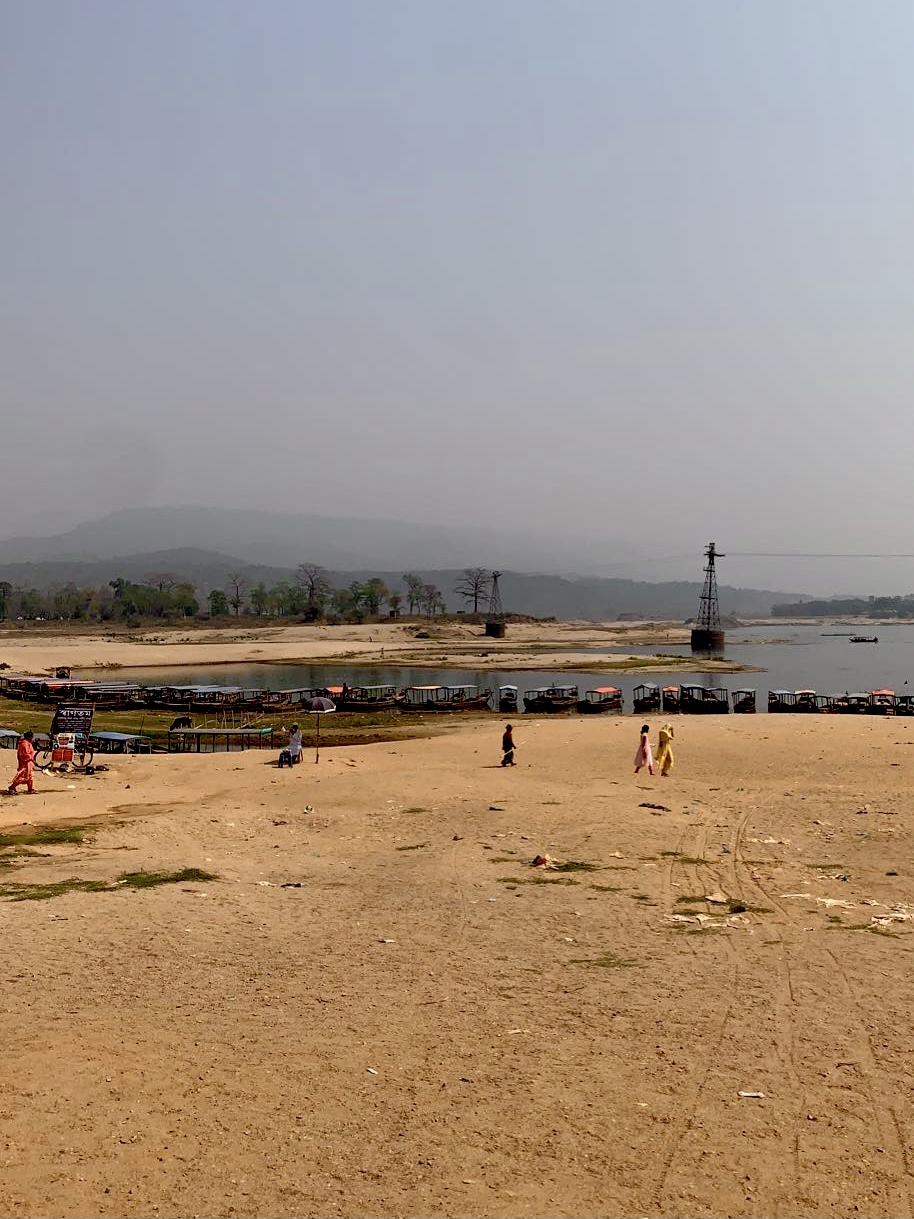
Powerlines near what was a shallow river because of the hot, dry season in Bhologanj, Bangladesh.
Conclusion
Energy access has the potential to both inhibit and advance societies, depending on whether they are on the receiving end. The implementation of renewable energy sources and the availability of increased information and subsidies in rural communities can allow them to not be burdened by poor health, rising heat temperatures and darkness. Although electricity has reached many parts of Bangladesh, it is imperative that energy remains available throughout the day for various private and public spheres to thrive. In doing so, Bangladesh can economically prosper, as its population will become more efficient within different industries when they are not limited by power cuts and the discomfort of heatwaves and pollution. Thus, affordable and clean energy for all will not only improve local conditions, but help to mitigate climate change globally, as sustainable and clean energy become the norm.
References
Amin, S., Jamasb, T., Llorca, M., Marsiliani, L., & Renström, T. I. (2022). Decarbonisation policies and energy price reforms in Bangladesh. Energy Policy, 170, 113224. https://doi.org/10.1016/j.enpol.2022.113224
Anenberg, S. C., Balakrishnan, K., Jetter, J., Masera, O., Mehta, S., Moss, J., & Ramanathan, V. (2013). Cleaner cooking solutions to achieve health, climate, and Economic Cobenefits. Environmental Science & Technology, 47(9), 3944–3952. https://doi.org/10.1021/es304942e
Asghar, N., Amjad, M. A., & Rehman, H. ur. (2022). Analyzing the impact of access to electricity and biomass energy consumption on infant mortality rate: A global perspective. Environmental Science and Pollution Research, 30(11), 29550–29565. https://doi.org/10.1007/s11356-022-24144-9
Barney, N., & Courtemanche, M. (2023, May 25). load shedding. Data Center. https://www.techtarget.com/searchdatacenter/definition/load-shedding
Debnath, K. B., & Mourshed, M. (2022). Why is Bangladesh’s electricity generation heading towards a GHG emissions-intensive future? Carbon Management, 13(1), 216–237. https://doi.org/10.1080/17583004.2022.2068454
Dincer, I., & Acar, C. (2015). A review on clean energy solutions for better sustainability. International Journal of Energy Research, 39(5), 585-606.
Hosan, S., Sen, K. K., Rahman, Md. M., Karmaker, S. C., Chapman, A. J., & Saha, B. B. (2023). Evaluating the mediating role of energy subsidies on social well-being and energy poverty alleviation in Bangladesh. Energy Research & Social Science, 100, 103088.https://doi.org/10.1016/j.erss.2023.103088
Hossain, S. M., & Hasan, M. M. (2018). Energy Management through Bio-gas Based Electricity Generation System during Load Shedding in Rural Areas. Telkomnika, 16(2), 525–532. https://doi-org.ezproxy.capilanou.ca/10.12928/TELKOMNIKA.v16i2.5190
Ichord, R. F. (2020). Transforming the Power Sector in Developing Countries: Geopolitics, Poverty, and Climate Change in Bangladesh. Atlantic Council. http://www.jstor.org/stable/resrep23544
IEA. (n.d.). Bangladesh – Countries & Regions. IEA. https://www.iea.org/countries/bangladesh
IPS Price in Bangladesh 2023. bdstall.com. (n.d.). https://www.bdstall.com/ips-instant-power-supply/#:~:text=In%20BD%2C%20the%201000%20watt,large%20families%20and%20small%20office
Islam, S., & Khan, Md. Z. (2017). A review of energy sector of Bangladesh. Energy Procedia, 110, 611–618. https://doi.org/10.1016/j.egypro.2017.03.193
Keyun, D., Shuhua, G., & Wenqiang, L. (1996). Rural Energy Development in China. Energy for Sustainable Development, 3(3), 31–36. https://doi.org/10.1016/s0973-0826(08)60193-3
Kundo, H. K., Brueckner, M., Spencer, R., & Davis, J. K. (2023). The politics of linking disaster risk reduction and climate adaptation with social protection in Bangladesh. International Journal of Disaster Risk Reduction, 89, 103640. https://doi.org/10.1016/j.ijdrr.2023.103640
Mahmud, F. (2023, June 8). Bangladesh suffers long power cuts amid worst heatwave in decades. Al Jazeera. https://www.aljazeera.com/news/2023/6/8/bangladesh-suffers-long power-cuts-amid-worst-heatwave-in-decades
Markandya, A., & Wilkinson, P. (2007). Electricity generation and health. Lancet, 370(9591), 979–990. https://doi-org.ezproxy.capilanou.ca/10.1016/S01406736(07)61253-7
Mazur, A. (2011). Does increasing energy or electricity consumption improve quality of life in industrial nations? Energy Policy, 39(5), 2568–2572. https://doi.org/10.1016/j.enpol.2011.02.024
Miskat, M. I., Sarker, P., Chowdhury, H., Chowdhury, T., Rahman, M. S., Hossain, N., Chowdhury, P., & Sait, S. M. (2023). Current Scenario of Solar Energy Applications in Bangladesh: Techno-Economic Perspective, Policy Implementation, and Possibility of the Integration of Artificial Intelligence. Energies (19961073), 16(3), 1494. https://doi.org.ezproxy.capilanou.ca/10.3390/en16031494
Mondal, D., & Paul, P. (2020). Effects of indoor pollution on acute respiratory infections among under-five children in India: Evidence from a nationally representative population-based study. PLoS ONE, 15(8), 1–13. https://doiorg.ezproxy.capilanou.ca/10.1371/journal.pone.0237611
Moniruzzaman, M., & Day, R. (2020). Gendered Energy Poverty and Energy Justice in rural Bangladesh. Energy Policy, 144, 111554. https://doi.org/10.1016/j.enpol.2020.111554
Prizzon, A. (2020). External finance for rural development: Country case study: Bangladesh. ODI. http://www.jstor.org/stable/resrep51299
Sambodo, M. T., & Novandra, R. (2019). The state of energy poverty in Indonesia and its impact on Welfare. Energy Policy, 132, 113–121. https://doi.org/10.1016/j.enpol.2019.05.029
Sarkar, M., & Islam, S. (1998). Rural energy and its utilization in Bangladesh. Energy, 23(9), 785–789. https://doi.org/10.1016/s0360-5442(98)00018-8
Sarker, S. A., Wang, S., Adnan, K. M. M., Anser, M. K., Ayoub, Z., Ho, T. H., Tama, R. A. Z., Trunina, A., & Hoque, M. M. (2020). Economic Viability and Socio-Environmental Impacts of Solar Home Systems for Off-Grid Rural Electrification in Bangladesh. Energies (19961073), 13(3), 679. https://doi-org.ezproxy.capilanou.ca/10.3390/en13030679
Sen, K. K., Karmaker, S. C., Hosan, S., Chapman, A. J., Uddin, M. K., & Saha, B. B. (2023). Energy poverty alleviation through financial inclusion: Role of gender in Bangladesh. Energy, 282, 128452. https://doi.org/10.1016/j.energy.2023.128452
Shinn, L. (2022, June 1). Renewable Energy: The Clean Facts. NRDC. https://www.nrdc.org/stories/renewable-energy-clean-facts#sec-whatis
Solar most viable power source in Bangladesh. The Business Post. (2023, October 2). https://businesspostbd.com/power-energy/solar-most-viable-power-source-in-bangladesh#:~:text=In%20contrast%2C%20the%20report%20suggests,meeting%20Bangladesh’s%20escalating%20electricity%20demand.
Tajmim, T., & Islam, M. J. (2023, June 6). Frequent Power Cuts Cripple Hospitals, education institutes. The Business Standard. https://www.tbsnews.net/bangladesh/energy/frequent-power-cuts-cripple-hospitals-education-institutes-644702
Uddin, N., & Taplin, R. (2015). Regional cooperation in widening energy access and also mitigating climate change: Current programs and future potential. Global Environmental Change, 35, 497–504. https://doi.org/10.1016/j.gloenvcha.2015.05.006
United Nations. (n.d.-b). Energy – United Nations Sustainable Development. United Nations. https://www.un.org/sustainabledevelopment/energy/
World Bank Group. (2021, April 9). Lighting up rural communities in Bangladesh: The Second Rural Electrification and Renewable Energy Development Project. World Bank. https://www.worldbank.org/en/results/2021/03/13/lighting-up-rural-communities-in-bangladesh-the-second-rural-electrification-and-renewable-energy-development-project
World Health Organization. (2023, August 31). Electricity in health-care facilities. World Health Organization. https://www.who.int/news-room/fact-sheets/detail/electricity-in-health-care-facilities#:~:text=Electricity%20is%20needed%20to%20power,communications%20and%20clean%20water%20supply.
Zhou, D. (2009, August 7). The process of sustainable energy development in China. Carnegie Endowment For International Peace. https://carnegieendowment.org/2009/08/07/process-of-sustainable-energy-development-in-china-pub-23482
Individual interviews were conducted with Heather Chappells and Saifur Rahman.
